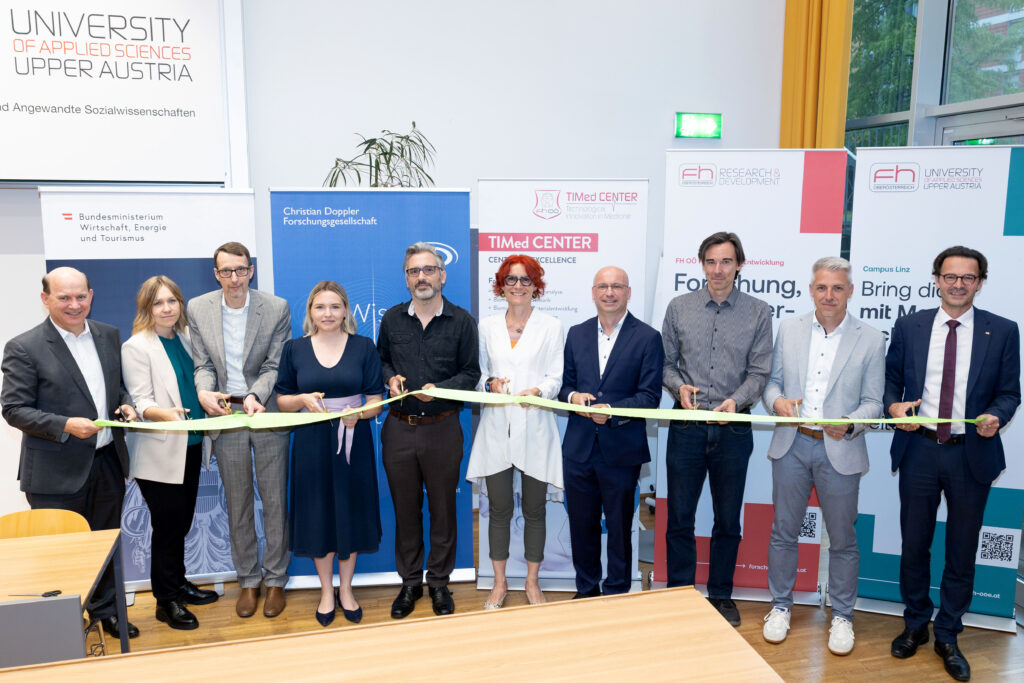Based at the Department of Medical Engineering at the University of Applied Sciences Upper Austria (FH OÖ) in Linz and run in cooperation with the Ludwig Boltzmann Institute for Traumatology in Vienna, the centre will focus on researching three-dimensional, light-modulated tissue printing for muscle regeneration.
The Centre’s primary goal is to develop 3D cell scaffolds from so-called bioinks. For this, species-specific proteins of the extracellular matrix (ECM) of muscle tissue are modified and made printable in 3D. Light-modulated ECM printing is then achieved using multiphoton lithography and direct light processing. The bioink components are cured using light, creating a high-resolution tissue scaffold. To minimize protein damage caused by light absorption and heat, the properties of the ECM proteins are chemically optimized.

Federal Ministry Supports Practice-Oriented Research
Josef Ressel Centres are co-financed by the Federal Ministry of Economy, Energy and Tourism in collaboration with committed industry partners. Federal Minister Wolfgang Hattmannsdorfer emphasizes:
“Whether in cases of organ failure, tissue damage, or muscle degeneration, the vision of producing functional tissue structures via 3D printing and populating them with the body’s own cells may sound like science fiction. But it is precisely this future that holds tremendous medical potential. Realizing it requires excellent research, and the Josef Ressel Centre makes a significant contribution in this regard. I wish the entire team every success in their pioneering work.”
FH Upper Austria Provides Cutting-Edge Infrastructure
“The practice-oriented research at the University of Applied Sciences Upper Austria is crucial to maintaining the innovative edge of the Upper Austrian economy,” states Regional Minister for Economic and Research Affairs, Markus Achleitner. “Thanks to the support of the province, FH Upper Austria can offer top-level infrastructure for leading research, particularly in Josef Ressel Centres like this new centre for Materials Engineering in Soft Tissue Regeneration in Linz. These investments are bearing fruit: with five of the 17 centres located here, FH Upper Austria has attracted more Josef Ressel Centres than any other institution in the country, contributing significantly to its status as Austria’s leading university of applied sciences in research.”
Mimicking Skeletal Muscle Tissue
“These printed scaffolds replicate the structure of smooth and skeletal muscle tissue,” explains FH-Prof. PD Dr. Jaroslav Jacak of FH Upper Austria, head of the new JRC. “They enable precise control over geometry and structure, allow for use as personalized tissue replacements, and improve existing experimental and translational models.”
Physicist Jacak will lead a team of two postdocs, four PhD students, and one technician together with physician Dr. Paul Slezak of the Ludwig Boltzmann Institute for Traumatology. Industry partners include the Innsbruck-based company Innovacell and Particle Metrix, located near Munich.
What Happens with the 3D Cell Scaffolds?
To recreate synthetic muscle tissue, the 3D scaffolds are populated with muscle cells. A new in vitro cell system is being developed to convert skeletal muscle cells into functional muscle fibers or smooth muscle cells.
Standardized protocols for mechanical and electrical stimulation are being developed to promote maturation of the 3D muscle models and facilitate the analysis of biochemical and mechanical signals to improve muscle function. At the same time, tools for assessing the functionality and quality of these models are being created, with a particular focus on gene analytics and released factors such as extracellular vesicles (EVs).
“Over the course of the project, the 3D cell scaffolds will be adapted for use in muscle defects, the cell systems modified, and the composition of the protein-based bioink materials further optimized,” explains project partner Dr. Paul Slezak, head of the research group at the LBI for Traumatology. According to Slezak, muscle defect models will be used to evaluate the regenerative properties of the muscle-cell-populated scaffolds. Their functionality will be further enhanced through mechanical and biochemical stimulation, with the ultimate goal of making them suitable for implantation.
Expectations from Industry Partners
“Alongside the identification of new stimulation techniques, this research will contribute to improving the clinical impact of Innovacell’s cell therapy products,” says Dr. Rainer Marksteiner, CEO of Innovacell, a company founded around 20 years ago. Of particular interest to him is the fundamental knowledge being generated for the development of customized extracellular 3D matrices that can be populated with cells and support regeneration of severely damaged tissue.